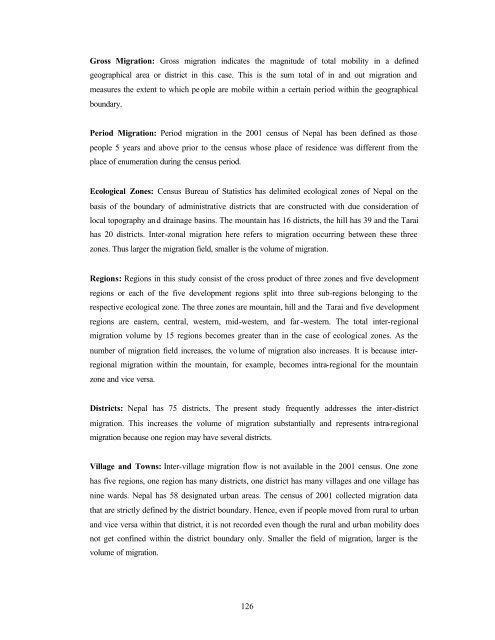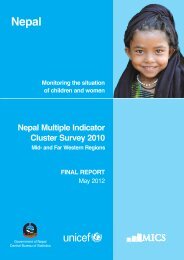Chapter 15 Internal Migration in Nepal - Central Bureau of Statistics
Chapter 15 Internal Migration in Nepal - Central Bureau of Statistics
Chapter 15 Internal Migration in Nepal - Central Bureau of Statistics
Create successful ePaper yourself
Turn your PDF publications into a flip-book with our unique Google optimized e-Paper software.
Gross <strong>Migration</strong>: Gross migration <strong>in</strong>dicates the magnitude <strong>of</strong> total mobility <strong>in</strong> a def<strong>in</strong>ed<br />
geographical area or district <strong>in</strong> this case. This is the sum total <strong>of</strong> <strong>in</strong> and out migration and<br />
measures the extent to which pe ople are mobile with<strong>in</strong> a certa<strong>in</strong> period with<strong>in</strong> the geographical<br />
boundary.<br />
Period <strong>Migration</strong>: Period migration <strong>in</strong> the 2001 census <strong>of</strong> <strong>Nepal</strong> has been def<strong>in</strong>ed as those<br />
people 5 years and above prior to the census whose place <strong>of</strong> residence was different from the<br />
place <strong>of</strong> enumeration dur<strong>in</strong>g the census period.<br />
Ecological Zones: Census <strong>Bureau</strong> <strong>of</strong> <strong>Statistics</strong> has delimited ecological zones <strong>of</strong> <strong>Nepal</strong> on the<br />
basis <strong>of</strong> the boundary <strong>of</strong> adm<strong>in</strong>istrative districts that are constructed with due consideration <strong>of</strong><br />
local topography an d dra<strong>in</strong>age bas<strong>in</strong>s. The mounta<strong>in</strong> has 16 districts, the hill has 39 and the Tarai<br />
has 20 districts. Inter-zonal migration here refers to migration occurr<strong>in</strong>g between these three<br />
zones. Thus larger the migration field, smaller is the volume <strong>of</strong> migration.<br />
Regions: Regions <strong>in</strong> this study consist <strong>of</strong> the cross product <strong>of</strong> three zones and five development<br />
regions or each <strong>of</strong> the five development regions split <strong>in</strong>to three sub-regions belong<strong>in</strong>g to the<br />
respective ecological zone. The three zones are mounta<strong>in</strong>, hill and the Tarai and five development<br />
regions are eastern, central, western, mid-western, and far -western. The total <strong>in</strong>ter-regional<br />
migration volume by <strong>15</strong> regions becomes greater than <strong>in</strong> the case <strong>of</strong> ecological zones. As the<br />
number <strong>of</strong> migration field <strong>in</strong>creases, the vo lume <strong>of</strong> migration also <strong>in</strong>creases. It is because <strong>in</strong>terregional<br />
migration with<strong>in</strong> the mounta<strong>in</strong>, for example, becomes <strong>in</strong>tra-regional for the mounta<strong>in</strong><br />
zone and vice versa.<br />
Districts: <strong>Nepal</strong> has 75 districts. The present study frequently addresses the <strong>in</strong>ter-district<br />
migration. This <strong>in</strong>creases the volume <strong>of</strong> migration substantially and represents <strong>in</strong>tra-regional<br />
migration because one region may have several districts.<br />
Village and Towns: Inter-village migration flow is not available <strong>in</strong> the 2001 census. One zone<br />
has five regions, one region has many districts, one district has many villages and one village has<br />
n<strong>in</strong>e wards. <strong>Nepal</strong> has 58 designated urban areas. The census <strong>of</strong> 2001 collected migration data<br />
that are strictly def<strong>in</strong>ed by the district boundary. Hence, even if people moved from rural to urban<br />
and vice versa with<strong>in</strong> that district, it is not recorded even though the rural and urban mobility does<br />
not get conf<strong>in</strong>ed with<strong>in</strong> the district boundary only. Smaller the field <strong>of</strong> migration, larger is the<br />
volume <strong>of</strong> migration.<br />
126
















